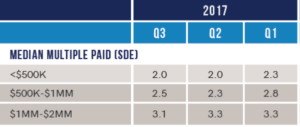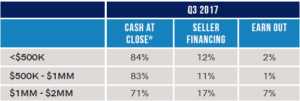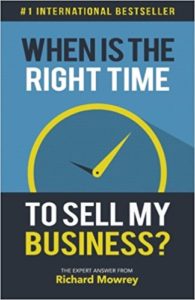Protect your Trade Name and Protect your Business Value
From my experience as an M&A Broker, I can tell you that your company’s trade name will be a valuable asset to most prospective buyers of your business. Your trade name, which identifies your company’s brand and distinguishes its reputation with customers and suppliers, is worth strengthening and protecting if you plan to sell your company some day.
It may surprise you that the name of your business, even if it’s not officially registered, receives some legal protection as a trademark. Protection for unregistered marks is based on common law and the federal Lanham Act. Generally the first documented use of a trade name within a geographic area receives some measure of protection.
But the value of your trade name can be threatened if you don’t safeguard it. When a competitor starts to use a name similar to yours it can cause confusion in the market place and impact your business. For an asset as valuable as the name of your business, it’s wise to proactively protect it.
In California, any company doing business in the state under a fictitious name must register that name in the county where the business operates. Once registered, you as the owner will be able to sign contracts and engage in financial transactions under the fictitious name (also known as Doing Business As or DBA). California follows the first use rule when determining the ownership of a trademark. Fictitious name registration can also be useful to document how long you have been using your business name, in case it’s ever contested. However, fictitious business name registration does not necessarily protect your trade name throughout the state or in other states where you are doing business.
Registering your business’ name as a trademark at the state or federal level is the surest way to shelter it from unauthorized use and provide assurance to potential acquirers that they too would be able to benefit from the goodwill that the name generates.
The Secretary of State maintains the trademark registry for the State of California. Registering your trademark at the state level is generally easier and less expensive than a federal registration. However, there are some real benefits to registering through the United States Patent and Trademark Office. Federal registration is a more robust protection because it:
- Makes it easier to bring infringement matters to federal courts
- Increases remedies for trademark infringement
- Has priority over state registration. If a federally registered trademark was in use before a state registered trademark, the federal registrant can stop the state trademark owner from using the mark. If the state mark was in use first, the mark’s use may be restricted to the state where it was registered.
Possibly the most attractive benefit of registering a trademark at the federal level is that after five years of not being challenged the trademark can become eligible for “incontestability”. Incontestable trademarks are, under normal circumstances, immune from being challenged.
To protect the value of your trade name (and your brand) it is worth considering federal trademark registration, especially if you plan to sell your business someday.
Most businesses also have an online presence. It is equally important (and in some cases far more so) to protect your trade name through marketing channels on the web and social media. At minimum you should acquire through Google or GoDaddy any domain names associated with your business.
Even if you don’t choose to utilize them, many owners will also want to claim their trade name and related monikers in Facebook, Instagram and other social media sites frequented by their clients. As with trademark registration, when you are looking to sell your business a prospective buyer will appreciate that you have diligently protected your business’ trade name and that you can transfer those protections as an asset of the sale.
For more information on protecting and maximizing the value of your business in a sale, email M&A broker Adam Wiskind at awiskind@exitstrategiesgroup.com or call 707-781-8744.
Please note that this article does not constitute legal advice on your situation! For legal advice, please contact an attorney with appropriate experience. If you need a referral to an attorney we would be happy to provide a recommendation.

 Owner Attributes
Owner Attributes


 I was recently talking with a business owner who is considering selling his California company. He had found my contact information online, and while he was interested in getting started, he really didn’t know how to evaluate a business broker’s credentials for a sale engagement. Sellers are often unsure what questions to ask. For this reason, I like to spend 15 minutes to share my relevant M&A experience, my career history, our firm’s processes and resources, and our capacity to get a deal done for the prospective client. In this blog post, I’ll focus on pertinent questions that a seller should ask when interviewing a prospective business broker or M&A intermediary.
I was recently talking with a business owner who is considering selling his California company. He had found my contact information online, and while he was interested in getting started, he really didn’t know how to evaluate a business broker’s credentials for a sale engagement. Sellers are often unsure what questions to ask. For this reason, I like to spend 15 minutes to share my relevant M&A experience, my career history, our firm’s processes and resources, and our capacity to get a deal done for the prospective client. In this blog post, I’ll focus on pertinent questions that a seller should ask when interviewing a prospective business broker or M&A intermediary.
 I thought would share this brief Forbes article that came across my transom early this morning. I generally agree with author John Warrillow’s comments on Strategic versus Financial buyers. If your goal is to maximize value and liquidity today, and you’re not looking for an equity partner to help you build longer term enterprise value, a strategic buyer generally produces the best outcome. Having multiple strategic buyers at the negotiating table as a result of a structured M&A sale process produces even better results!
I thought would share this brief Forbes article that came across my transom early this morning. I generally agree with author John Warrillow’s comments on Strategic versus Financial buyers. If your goal is to maximize value and liquidity today, and you’re not looking for an equity partner to help you build longer term enterprise value, a strategic buyer generally produces the best outcome. Having multiple strategic buyers at the negotiating table as a result of a structured M&A sale process produces even better results!

